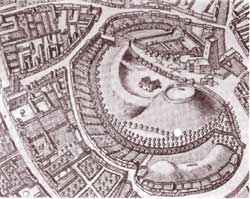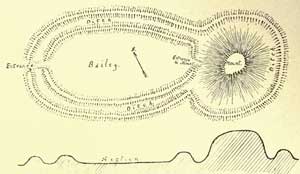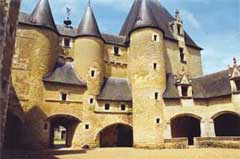Motte and Bailey Castles
The name of the motte-and-bailey castles derives from the old French word motte, meaning a clod of earth, and the word bailey, or ballium, which literally means a palisaded enclosure.
The motte was usually entirely artificial, however, sometimes the castle was also taking advantage of natural elevation. The wooden or stone keep topped the motte. Very rarely the castle could have two mottes, the only instances in England being at Lewes and Lincoln.
The normal form of this type of castle could be approximated as a figure of eight, with the lower portion elongated and widened to form the bailey.
The chronicles do not contain any description of the motte-and-bailey castle before the beginning of the 11th century. The first historical mention of a castle which is clearly of the motte-and-bailey kind is in the Chronicle of St. Florent Ie Vieil, where we learn that, in 1010, Fulk Nerra, the Count of Anjou, built a castle on the western side of the hill Mont-Glonne, on the Loire, and threw up an agger on which he built a wooden tower. In this case the word agger evidently means a motte.
One of the theories regarding the motte-and-bailey castles is crediting Fulk Nerra as their inventor. This was based on the fact that, besides his fame in military architecture, he was the first leader who is known to have employed mercenary troops.
And, the plan of the motte-and-bailey castles strongly suggests a connection between their layout and the use of mercenaries. While the castle was meant to protect against the enemies of its owner, it also appears that the lord of the castle did not completely trust his garrison.

Motte-and-bailey castle at Oxford
Bird's eye view by David Loggan - 1675
The keep in which he and his family were living is placed on the top of the motte, which is ditched round so as to separate it from the bailey. The provisions on which all were dependent were stored in the cellar of the keep, under his control, and the keys of the outer ward were brought to him every night, and placed under his pillow.
However, there is evidence of mottes at an earlier period in the 10th century, before Fulk Nerra. Thibault le Tricheur, who was Count of Blois and Chartres from 932 to 962, was also a great builder. The records mention him as the one who built the keeps of Chartres, Chateaudun, Blois, and Chinon, and the castle of Saumur.
All these must have been finished before 962. For sure there was a motte at Blois, as the chronicles are recording that in the 12th century, Fulk V of Anjou burnt the whole fortress, “except the house on the motte.” There was also a motte at Saumur, and the plan of the castle of Chinon is also suggesting the existence of a former motte. These instances are pushing the existence of the motte-and-bailey castle back to the middle of the 10th century.
If we accept the statement of Lambert of Ardres that Sigfrid the Dane, who occupied the county of Guisnes about the year 928, fortified the town, and enclosed his own dunio with a double ditch, then this is a clear instance of a motte built in the first half of the 1oth century. But Lambert’s work was written at the end of the 12th century, to glorify the counts of Guisnes, and even its editor regards the early part as fabulous. So, even if we accept that Sigfrid fortified the town of Guisnes, as the Danes commonly did, it is unlikely that he built himself a castle.

Motte-and-bailey castles
The common, 8-shaped layout, and section
The motte-and-bailey castles were almost invariably placed in the arable country, not isolated, but in the immediate neighborhood of towns or villages.
Whenever a motte was raised, the first castle had to be a wooden one. A stone keep could not be placed on loose soil, so the motte must always represent the oldest castle. However, the motte-and-bailey castles were not temporary expedients, intended to be replaced by stone buildings. Even after stone castles had been fully developed, wood continued to be used as a solid building material, until a very late period. Mottes were used not only throughout the 11th and 12th centuries, but even as late as the 13th.
The motte-and-bailey type of castle is to be found throughout feudal Europe, but is probably more prevalent in France and the British Isles than anywhere else.

